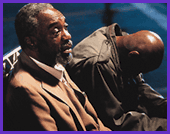Cinematographer John Bailey, ASC returns to television for the first time in 15 years to collaborate with director Michael Apted on HBO's ALWAYS OUTNUMBERED, a compelling story about streetwise survivors.
Even a cinematographer as accomplished as John Bailey, ASC, who has built his considerable reputation on such films as Ordinary People, American Gigolo, The Big Chill, Silverado, In the Line of Fire and As Good As It Gets, admits that he was nervous at the prospect of returning to television after an absence of more than 15 years. He says he signed on to do Always Outnumbered, the HBO film adaptation of Walter Mosley's new book, Always Outnumbered, Always Outgunned, largely because he so enjoys working with director Michael Apted. "I'd shoot just about anything he'd want me to do," says Bailey. "I loved the script, which is a contemporary African-American urban drama that doesn't exploit the culture of drugs and violence. Also, I deeply admire Laurence Fishburne, who plays the title role, and I was eager to work with him."
Mosley's novel is a collection of interlocking stories about Socrates Fortlow (Fishburne), an ex-convict struggling to maintain his dignity while living in the tough turf of South Central, a predominantly black Los Angeles neigborhood. In part, the movie focuses on the small, daily rituals of Fortlow life, which include collecting the bottles and cans by which he earns his livelihood. It also concerns his relationship with two people: an older friend, Right Burke (Bill Cobbs), who is sick and dying, and a violence-prone 11-year-old street kid named Darryl (Daniel Williams). Socrates takes the youngster under his wing and tries to teach him how to live with pride and morality in a world that is essentially hostile to black men.
"Since I hadn't done television for so long, I had to start thinking differently," says Bailey, who began his career as a camera assistant on commercials and National Gegraphic documentaries. "Obviously, for television I had to think in terms of the different [1.33:1] aspect ratio. What I found was that I essentially had to make the images and lighting less complex, a little bit reductive."
Since shooting The Accidental Tourist in anamorphic 10 years ago, Bailey has worked mainly in widescreen 2.35:1, a format he now considers to be second nature. "Suddenly, on Always Outnumbered, I was dealing with a frame that was almost half that width. You are not able to have as much visual information in the field, so what you do put in has to be significant. There's also not a lot of time for the eye to roam around."
According to the cameraman, what matters in television is the raw emotion of the human face. Due to the size of the average TV screen, if there are too many objects competing with a face, the image all becomes a blur: too much peripheral material is distracting.
On Always Outnumbered, Bailey consistently found himself removing background material from the frame, such as pictures on walls, or objects on tables. He either moved things to a corner of the frame or eliminated them entirely. "If there were things on the walls behind the actors that I couldn't move or didn't want to because they had been established, I tried to make the wall go away by taking light off of it," he says. "I'd bring the faces into the foreground. Television viewers aren't that interested in the larger scale, because those things don't really translate too well to the medium."
Bailey also found himself using wider lenses, favoring the wide end (17mm-24mm) of the Primo 4:1 zoom. For close-ups, he leaned toward a 32mm or 35mm. Although Always Outnumbered will have a theatrical release overseas (as do most HBO movies), Bailey used more extreme close-ups and medium shots than he would have for a true feature film. His standard-size close-up on an anamorphic film includes the shoulders. "Getting into a close-up that cuts into the chin and forehead is not something that I would normally do while shooting a theatrical feature. I find it often to be incredibly intrusive. You can do it on TV, however, because even if you have a 35-inch screen, you're sitting eight or 10 feet away and the screen image doesn't fill that much of your field of view.
[ continued on page 2 ]
